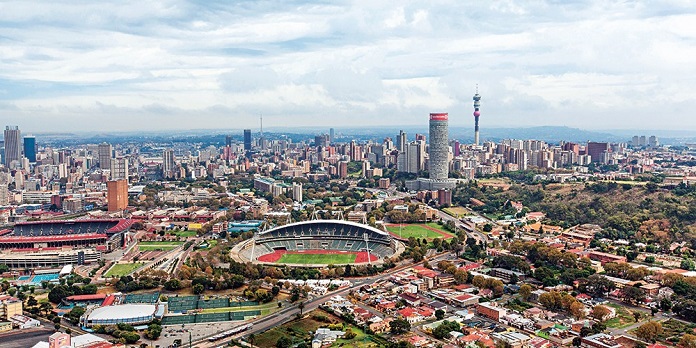Some of the biggest cities in South Africa are also are among the most popular and visited cities on the African continent. This is mainly because of their fascinating outlook, great infrastructure, and well structured urban planning as they have been developed to global standards.
Over the years, South Africa, which previously suffered the woes of apartheid, has grown to become a great tourist destination among global tourists seeking adventurous pastimes. From Johannesburg to Cape Town and Durban, the best cities in South Africa are known to have a very impressive wealth of things to see and do for people who come to visit the southern African nation. Some of these South African cities have recorded very impressive economic developments over the years and also have huge populations that are made up of a vast array of different races and languages.
The Biggest Cities In South Africa
1. Johannesburg
- Population: 5,635,127
- Population Density: 2,364 per square kilometre (6,120/sq mi)
- Province: Gauteng
- Municipality: City of Johannesburg
- GDP: US$76 billion
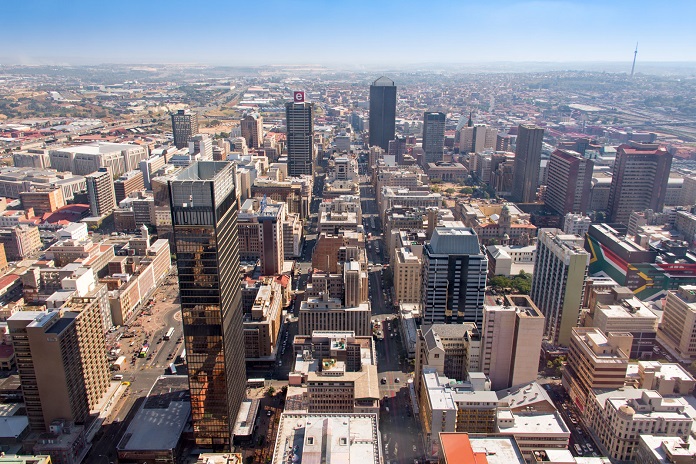
The Population Makeup of Johannesburg
There are currently more than 5 million people resident in the city of Johannesburg which puts it ahead of every other South African city in terms of population. Johannesburg’s population is 5,635,127, making it the most populous city in South Africa and one of the nation’s most popular cities. The population is made up of different races and, of course, ages and languages.
Races
People of different races reside in Johannesburg. At the moment, black people make up the majority of Johannesburg’s popularity. A whopping 73% of the population of Johannesburg are blacks. The black population is followed from far behind by white people who make 18% of the population.
Colored people come next; they make about 6% of the population and, lastly, Asians make up about 4% of the population of Johannesburg.
Ages
The people living in Johannesburg are mostly young. 42% of the entire population of the city is under the age of 24. Only about 6% of the population is over 60 years.
Languages
As expected, the residents of Johannesburg speak different languages. About 32% of the people living in the city speak Nguni languages at home while about 24% of the residents speak Sotho languages. However, another 18% of the people speak the English language and 7% speak Afrikaans. Lastly, only 6% of the population speak Tshivenda.
How Big is The Economy of Johannesburg?
The economy of Johannesburg has grown in huge proportions over the years. As a matter of fact, the city is now considered to be the economic and financial hub of South Africa. With a GDP of US$76 billion, Johannesburg is responsible for the production of about 16% of South Africa’s gross domestic product. The city is also reported to account for about 40% of the economic activity in the Gauteng province.
Johannesburg has manufacturing industries that actually extend across a range of areas. Records show that the city has a reliance on some heavy industries including steel and cement plants. Other industries thriving in Johannesburg include broadcast and print media, banking, real estate, health care, IT, and others. It is on record that the city of Johannesburg happens to have the largest stock exchange in Africa.
The Amazing Infrastructure in Johannesburg
When it comes to infrastructure, Johannesburg is right there at the top of the ladder of excellence not just among South African cities but among African cities as a whole. Johannesburg is one of the classiest and finest cities in South Africa and even on the African continent. The city has an intricately integrated public transportation system. The Johannesburg Ring Road is one of the most famous “beltways” or ring roads/orbitals in Africa. The city is served by a bus fleet operated by Metrobus. A well-planned rail system also serves the city and links it to other cities.
Some of the tallest buildings in South Africa are in Johannesburg and most of the buildings are owned by companies whose headquarters are located in the city. Below are some of these buildings and their owners.
- Carlton Centre Office Tower, a 50 story skyscraper owned by Transnet
- Ponte City Apartments, a 55-story building
- Standard Bank Centre, a 34-story building
- Trust Bank Building, a 31, story-building, and many others
2. Cape Town
- Population: 3,740,026
- Population Density: 1,500 per square kilometre (3,900/sq mi)
- Province: Western Cape
- Municipality: City of Cape Town
- GDP: US$78.7 billion
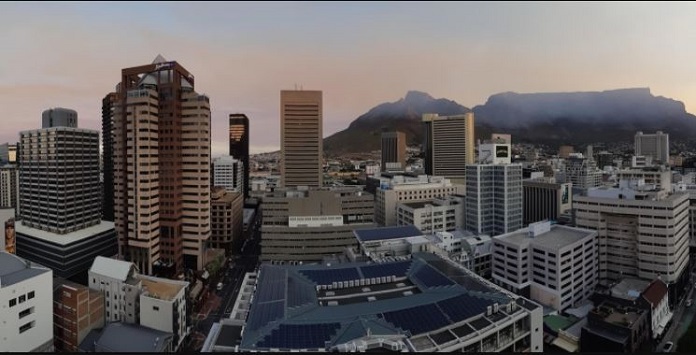
The Population Makeup of Cape Town
There are currently more than 3 million people living in Cape Town. The city is a bubbly one with lots of commercial activities and entertainment taking over it. As expected, the population of Cape Town is made up of different races and ages.
Races
The population of Cape Town is made up of mostly colored people. Colored people make up 42.4% of the population while 38.6% of people living in the city are Black Africans. Also, white people make up about 15.7% of the population, and 1.4% identify as Indian or Asian.
Ages
The people living in Cape Town are mostly young. 24.8% of the population is under the age of 15. However, 5.5% is 65 or older.
Languages
In Cape Town, 35.7% of the residents speak Afrikaans while 29.8% of the population speaks Xhosa. Also, about 28.4% of people speak the English language.
How Big is The Economy of Cape Town?
Cape Town is a very important economic center in South Africa. As a matter of fact, it is considered to be South Africa’s second main economic center and the economic hub of the Western Cape province. Also, Cape Town currently enjoys a booming real estate and construction market and is Africa’s third main economic hub city.
There are four major commercial nodes in Cape Town which arm residents with opportunities to thrive; The Cape Town Central Business District as well as the Century City, the Bellville/Tygervalley strip, and Claremont commercial nodes. The Cape Town Central Business District is especially reported to have the majority of job opportunities available in the city as well as office space. In addition, lots of insurance companies as well as shipping companies, advertising agencies, petrochemical companies, and more, have their headquarters in the city.
What The Infrastructure In Cape Town Looks Like
Cape Town has a well-developed infrastructure. The city is actually the origin of three national roads; The N1, N2, and the N7. It uses Metropolitan routes for important intra-city routes. There is also a public transport system in about 10% of the city. Cape Town also has the second-largest airport in South Africa. Some of the really tall buildings in the country include:
- Portside Tower, a 139-meter-tall owned by Baker Street Properties
- 1 Thibault Square, a 35-story building owned by Zenprop
- Metlife Centre
- Atterbury House, a 29-story building owned by Atterbury Property, and others.
3. Durban
- Population: 3,720,953
- Population Density: 16,000 per square kilometre (43,000/sq mi)
- Province: KwaZulu-Natal
- Municipality: eThekwini
- GDP: US$ 83.9 billion

The Population Makeup of Durban
There are now more than 3 million people living in Durban. Durban is the largest city in the province of KwaZulu-Natal and is also the third most populous South African city. Just like other cities, Durban’s population is made up of different kinds of people.
Races
The majority of the people resident in the city of Durban are Black Africans. Black Africans make up about 51.1% of the population while Indians or Asians make up about 24.0%. The population of White people is about 15.3% while the population of Coloureds is about 8.59%.
Ages
Reports show that majority of the people living in Durban are of working age. In fact, 68% of Durban’s residents are of working age while 38% of the city’s population are under the age of 19 years.
Languages
A majority of people living in Durban speak English. 49.8% of people in Durban speak the English language while 33.1% of the city’s residents speak Zulu. 5.9% of the population speak Xhosa and 3.6% speak Afrikaans.
The Economy of Durban
The economy of Durban is a very progressive one. In fact, the city of Durban is on record to have the highest number of dollar millionaires added per year of any South African city. One of Durban’s main industries is Sugar refining. It plays a big part in South Africa’s production of sugar which reaches an amazing 19.9 million tons of sugar cane a year.
It is also on record that the city of Durban has a massive informal sector. The city has several informal and semi-formal street vendors taking over sidewalks and streets. Plenty of street markets are especially seen at the Warwick Junction Precinct where vendors are usually displaying different goods ranging from clothing to traditional medicine, and spices.
The Infrastructure in Durban
Like other South African cities, Durban has a well-developed infrastructure. The city is positioned as a port of entry into South Africa so, national roads have been built around it. The city also has a system of freeway and dual arterial metropolitan routes and boasts of having many companies running long-distance bus services from its borders to the other cities in the country. A commuter rail service is operated in Durban by Metrorail. Also, the city boasts of a high-speed rail link that has been proposed between it and Johannesburg.
Durban has plenty of tall buildings including
- Pearl Dawn, a 31-story building offering luxury apartments and penthouses
- 88 on Field, a 26-story building
- Old Mutual Centre, a 33-story building
- The Spinnaker, a 29-story building
4. Pretoria
- Population: 2,472,612
- Population Density: 3,600 per square kilometre (9,300/sq mi)
- Province: Gauteng
- Municipality: City of Tshwane
- GDP: US$ 75.6 billion
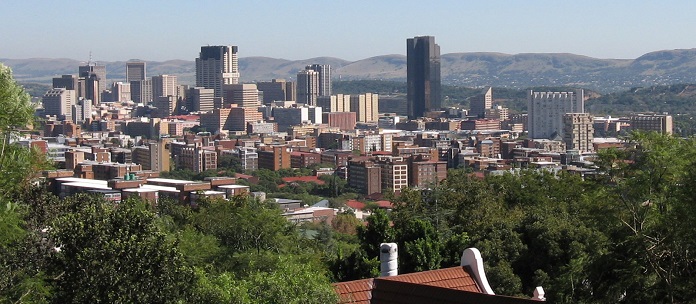
The Population Makeup of Pretoria
Pretoria serves as South Africa’s seat of the executive branch of government and now has more than 2 million living in it. The population of Pretoria is made up of different kinds of people.
Races
The majority of people living in Pretoria are Whites. As a matter of fact, about 52.5% of the city’s residents are White while 42.0% of the population is made up of Black Africans. 2.5% of the population is made up of Coloured folks and 1.9% comprise Indians or Asians.
Languages
The majority of people living in Pretoria speak Afrikaans. Reports show that about 47.7% of the city’s population speak Afrikaans while 16.4% speak the English language. Also, 8.0% of the residents of Pretoria speak Northern Sotho while 5.4% of people speak Tswana.
The Economy of Pretoria
Pretoria happens to be one of the very important industrial centers in South Africa. In fact, the city is known to have heavy industries, including iron and steel casting industries. You can also find the motor vehicle industry, the parts manufacturing industry, and government companies institutions.
The economy in Pretoria is ever-growing and this has made it a center point for developing small as well as big businesses. The city has once been reported to have the fastest-growing South African metro economy in recent times.
The Infrastructure in Pretoria
Pretoria also has a well-developed infrastructure. The city is served by many regional roads and enjoys commuter rail services that are operated by Metrorail. It is noteworthy that bus companies also exist in Pretoria.
The city of Pretoria boasts of hosting the headquarters of different companies, including the South Africa Iron and Steel Corporation (ISCOR) that manufactures most of the nation’s steel. It also has plenty of tall buildings including;
- South African Reserve Bank Building, a 38-story building
- Kruger Park Building, a 33-story building
- Civitas Building, a 31-story building
- Telkom Tower North, a 26-story building
5. Port Elizabeth
- Population: 967,677
- Population Density: 3,900 per square kilometre (10,000/sq mi)
- Province: Eastern Cape
- Municipality: Nelson Mandela Bay

The Population Makeup of Port Elizabeth
There are nearly a million people living in Port Elizabeth. This makes it the most populous city in the Eastern Cape province of South Africa. The city also happens to be the seat of the Nelson Mandela Bay Metropolitan Municipality. Port Elizabeth’s population is made up of different kinds of people.
Races
The majority of people living in Port Elizabeth are Whites. In fact, White people make up 37.8% of the population while Black Africans make up 30.6% of the population. Also, Coloured people make up 27.0% of the population while Indians or Asians form only 3.2%.
Languages
Different languages are spoken in Port Elizabeth. The most widely spoken language is Afrikaans. Reports show that 40.2% of the population in Port Elizabeth speak Afrikaans while 33.2% of the population speak the English language. In addition, 22.2% of the people speak Xhosa.
The Economy of Port Elizabeth
Port Elizabeth has a progressive economy. The city has an economy that is mainly oriented towards manufacturing, automotive assembly, and export industries, and it is also a major South African and sub-Saharan African destination for investment. Reports show that Port Elizabeth’s foreign direct investments of $19,8 billion have been secured over the past decade. Also, the city has experienced a construction boom.
Additionally, Port Elizabeth is often considered to be the home of the motor vehicle industry in South Africa. This is because most vehicle assembly plants in the country including Volkswagen, General Motors, Continental Tyres, Ford, and many other automotive companies are all located there. It is noteworthy that tourism also contributes a lot to the city’s economy. The city attracts thousands of tourists every year with its popular swimming beaches, local historic attractions, and whale watching provisions.
Infrastructure in Port Elizabeth
The infrastructure in Port Elizabeth is a well structured one. The city has a railway station that is served by South Africa’s rail network. As a major seaport city, Port Elizabeth has a harbor in Algoa Bay. The city has a public bus service that is run by the Algoa Bus Company and has a main bus station that is located in Market Square.
Many companies including several Fortune 500 companies are present or have their African operations headquartered in Port Elizabeth. The city also has plenty of tall buildings including;
- Sanport 140, a 22-story building
- Nelson Mandela Metropolitan University Main Building, a 21-story building
- The Beaches, a 20-story building
- Post Office Port Elizabeth, a 19-story building
- Brister House, an 18-story building
6. Vereeniging
- Population: 99,000
- Population Density: 530 per square kilometre (1,400/sq mi)
- Province: Gauteng
- Municipality: Emfuleni
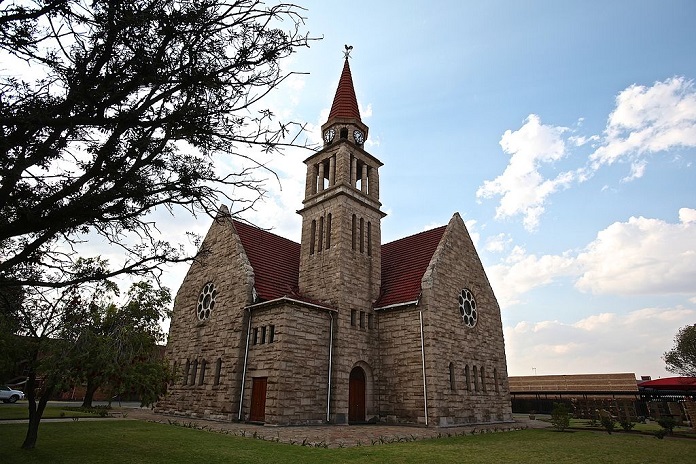
The Population Makeup of Vereeniging
Nearly 100,000 people currently live in Vereeniging, a city that happens to be one of the constituent parts of the Vaal Triangle region in South Africa. For the record, the name Vereeniging is actually a Dutch word that means “union”. The 99,000 people who live in the city are made up of different races and speak different languages.
Races
The majority of people who live in Vereeniging are Black Africans. Records show that about 55.0% of Vereeniging’s population are actually Black Africans while 33.1% of the population are Whites. Also, 5.8% of the population of Vereeniging are Indians or Asians while 5.1% are Coloured people.
Languages
The majority of the people living in Vereeniging speak Afrikaans. Records show that 34.9% of the people living in the city speak Afrikaans while 26.2% of the people speak Sotho. Also, 15.5% of the population speak the English language while 8.3% speak Zulu.
What is the Economy of Vereeniging Like?
Vereeniging is regarded as one of the most important industrial manufacturing centers in South Africa because of its manufacturing prowess. Different products, including iron, steel, pipes, bricks, tiles, and processed lime are manufactured there.
Also, many coal mines are hosted in Vereeniging and their reserves are estimated at four billion tons. In addition, many Eskom thermal power plants that supply electricity are located in Vereeniging. Sometimes, it has been joked that the city is the South African town that has the most vehicle dealerships per square meter.
The Infrastructure in Vereeniging
The infrastructure in Vereeniging is well planned. In fact, it is on record that the city was one of the first municipalities in South Africa to provide better housing for Africans. It hosts several health services like
- Vereeniging Medi-Clinic
- Midvaal Private Hospital
- Kopanong Hospital
- Sebokeng Hospital
Vereeniging also hosts several tertiary institutions like
- University of South Africa
- Damelin College
- CTU Training Solutions, and more
7. Soshanguve
- Population: 403,162
- Population Density: 3,200 per square kilometre (8,200/sq mi)
- Province: Gauteng
- Municipality: City of Tshwane

The Population Makeup of Soshanguve
The population of Soshanguve has a multi-ethnic composition as well as racial differences. Different languages are spoken in the city and it has even been said that the major African languages of South Africa are heard in Soshanguve.
Races
The population of Soshanguve comprises of different races. However, the overwhelming majority of Soshanguve’s population are Black Africans. In fact, 99.2% of the city’s population are Black Africans while Coloured folks make up 0.3% of the population. Also, White people make up 0.1% of the population. Interestingly, Indians and Asians also make up 0.1% of the population.
Languages
Different languages are spoken in Soshanguve. However, the majority of people in the city speak Northern Sotho. Reports show that 28.2 of the city’s population speak Northern Sotho while 26.5% of the residents speak Venda. Also, 16.7% of the population speak Tswana while 15.1% of the people speak Tsonga. It is also noteworthy that 13.6% of residents speak Zulu.
The Economy of Soshanguve
The economy of Soshanguve is not a very progressive one. Over the years, the many residents of the city have complained of lack of opportunities and even poor service delivery. It has been reported that many of the families in Soshanguve are poor and have to engage in small scale farming to earn a living. The city is known to be really close to very affluent areas, however, in sharp contrast, the majority of its residents are poor.
The Infrastructure in Soshanguve
Infrastructure in Soshanguve is not quite as impressive as in the other cities. However, the city plays host to a number of establishments. Soshanguve is actually home to the Tshwane University of Technology. It is also home to the second fab lab in South Africa. Other places of interest in Soshanguve include:
- Tswaing Crater
- Giant Stadium
- Soshanguve Crossing Mall
- Soshanguve Railway Station
- Tshwane North College
8. East London
- Population: 267,007
- Population Density: 1,600 per square kilometre (4,100/sq mi)
- Province: Eastern Cape
- Municipality: Buffalo City
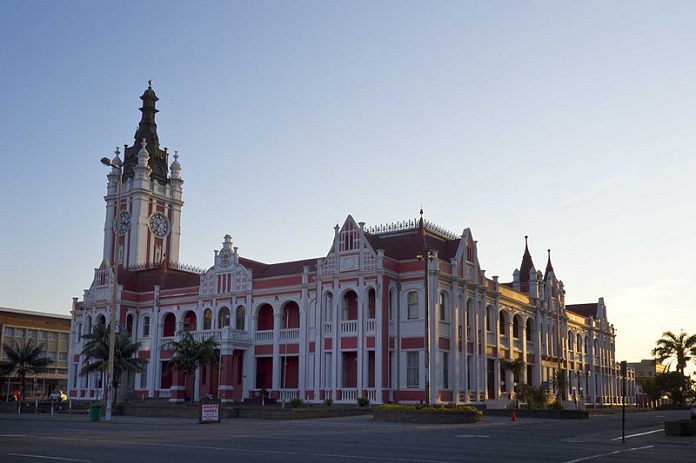
The Population Makeup of East London
As expected, the population of East London comprises of different races and tribes, and people who speak different languages.
Races
The majority of people who reside in East London are Black Africans. Reports show that an overwhelming 70.1% of the population of East London are Black Africans while 16.0% of the population are Whites. Also, 11.6% are Coloured people while 1.8% are Indians or Asians.
Languages
Most people who live in East London speak Xhosa. In fact, 61.8% of East London’s population speak Xhosa while 21.2% of the population speak the English language. Also, 13.3% of the residents speak Afrikaans.
The Economy of East London
The economy of East London is quite a progressive one as the city happens to be the second-largest industrial center in the Eastern Cape province. A dominant employer in East London is the motor industry. In fact, a major Daimler automotive manufacturing plant is located in East London where it manufactures Mercedes-Benz and other vehicles.
Apart from car manufacturing, there are other industries in East London, including textile, food processing, pharmaceutical, and clothing industries. The East London Industrial Development Zone (IDZ) was established on the West Bank in 2004 to encourage investment in East London.
The Infrastructure in East London
Infrastructure in East London is a well structured one. The city is serviced by two national roads and hosts a railway station which offers long-distance passenger services. The city also has a commercial airport and boasts of so many schools. Other different points of interest in the city are the East London Museum and Inkwenkwezi Private Game Reserve. There are lots of tall buildings in the city like:
- Caxton House, a 15-story building
- Emonti Hotel & Convention Centre, a 14-story building
- Fedlife Building, a 13-story building
9. Bloemfontein
- Population: 556,000
- Population Density: 2,400 per square kilometre (6,100/sq mi)
- Province: Free State
- Municipality: Mangaung
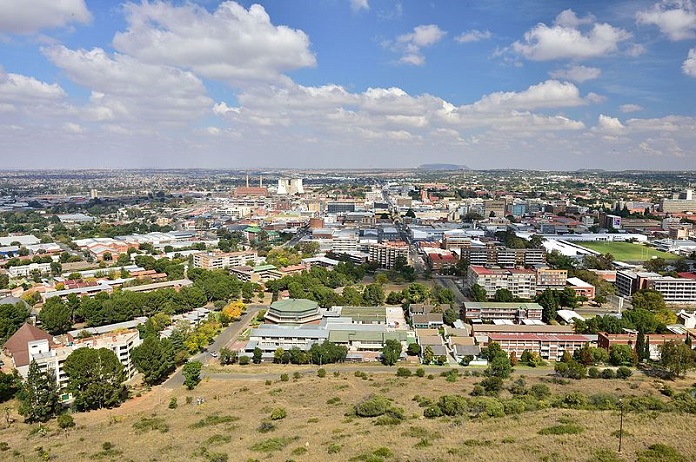
The Population Makeup of Bloemfontein
The population of Bloemfontein is a diverse one comprised of different races, tribes, and people who speak very different languages.
Races
The majority of people who reside in Bloemfontein are Black Africans. In fact, Black Africans make up 56.1% of Bloemfontein’s population while White people make up 29.8%. Also, 12.8% of the population are Coloured folks and 0.8% are Asians or Indians.
Languages
Different languages are spoken in Bloemfontein but the language spoken by most people is Afrikaans. As a matter of fact, 42.5% of the people speak Afrikaans while 33.4% of the population speak Sotho. Also, 7.5% of the people speak the English language while 7.1% speak Xhosa.
The Economy of Bloemfontein
The economy of Bloemfontein is a progressive one. Reports show that the economy of the city is driven by the private sector. It is on record that some of the largest retail companies in South Africa have their headquarters located in Bloemfontein.
The Infrastructure in Bloemfontein
Bloemfontein is rightly equipped with national and regional roads. It also has a number of metropolitan or ‘M’ roads that are well connected with rail. The city has two airports and has scheduled flights to all South African major cities.
It is on record that some major national private educational brands in South Africa have a presence in Bloemfontein. There are also lots of tall buildings and shopping malls in the city, including:
- Loch Logan Waterfront Mall
- Mimosa Mall
- Middestad Centre
- Northridge Mall
- Preller Walk Mall, and more
10. Pietermaritzburg
- Population: 618,536
- Population Density: 4,900 per square kilometre (13,000/sq mi)
- Province: KwaZulu-Natal
- Municipality: Msunduzi
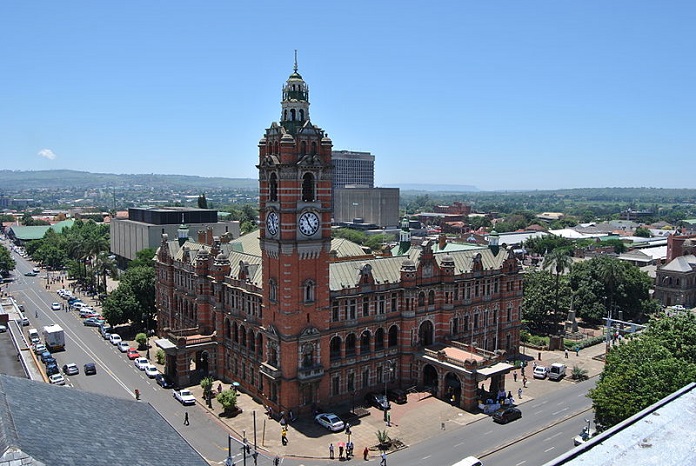
The Population Makeup of Pietermaritzburg
Like other top South African cities, the population of Pietermaritzburg comprises of people who are different racially and who speak different languages.
Races
There are different races of residents in Pietermaritzburg, however, Black Africans are the overwhelming majority. In fact, 81.1% of the population of Pietermaritzburg are Black Africans. 9.8% of the population are Indians or Asians while 6% of the population are White people. Also, 2.9% of people living in Pietermaritzburg are Coloured folks.
Languages
As expected, different languages are spoken in Pietermaritzburg but the majority of the city’s population speak Zulu. Records show that 57.0% of people living in Pietermaritzburg speak Zulu while 28.9% of the population speak the English language. Also, 4.2% of the population speak Afrikaans while 3.5% of the people speak Xhosa.
The Economy of Pietermaritzburg
The economy of Pietermaritzburg is a progressive one and the city is now considered to be a regionally important industrial hub. The city is the main economic hub of Umgungundlovu District Municipality and is known for its production of timber, aluminum, and dairy products. A major employer in Pietermaritzburg is the public sector. This is because the local, district, and provincial governments are located here.
There are also lots of timber plantations, as well as so many numerous citrus farms that extensively surround the city of Pietermaritzburg which help to enormously contribute a significant share of the city’s output.
The Infrastructure in Pietermaritzburg
The infrastructure of Pietermaritzburg is well-structured. The city is on the N3 highway and is served by the Pietermaritzburg Airport which regularly schedules services to OR Tambo International Airport in Johannesburg.
The city of Pietermaritzburg is home to many tertiary education institutions and other schools which include a campus of the University of KwaZulu-Natal. The city also has lots of tall buildings, including:
- Park Avenue, a 24-story building
- Natal Provincial Administration Offices, a 20-story building
- Nedbank Plaza, an 18-story building
- Club Lane Exchange Building, a 16-story building
Is The Largest City in South Africa Also The Richest?
There is a straight answer to this question and it is ‘yes!’ The biggest city in South Africa is also the richest city in that country. We are talking about Johannesburg! With more than 5 million living in the city, Johannesburg is the largest South African city but it is even more; it is also the wealthiest. Johannesburg is so rich that it is not only the richest city in South Africa but also the richest city on the African continent. It also ranks among the most expensive cities for luxuries in the world.
As South Africa’s business hub, Johannesburg is known for its concentration of high-paying jobs in different sectors, including telecommunications. For a long time, the city of Johannesburg has been renowned for its profitable trade in gold and diamonds. The city has also produced an amazing 13,900 millionaires and counting. As a matter of fact, the total wealth that is held by the millionaires in Johannesburg is about $209 billion and counting. It has also produced two of the country’s billionaires.
Interestingly the second biggest city in South Africa, Cape Town, is also the second richest city in the country.
